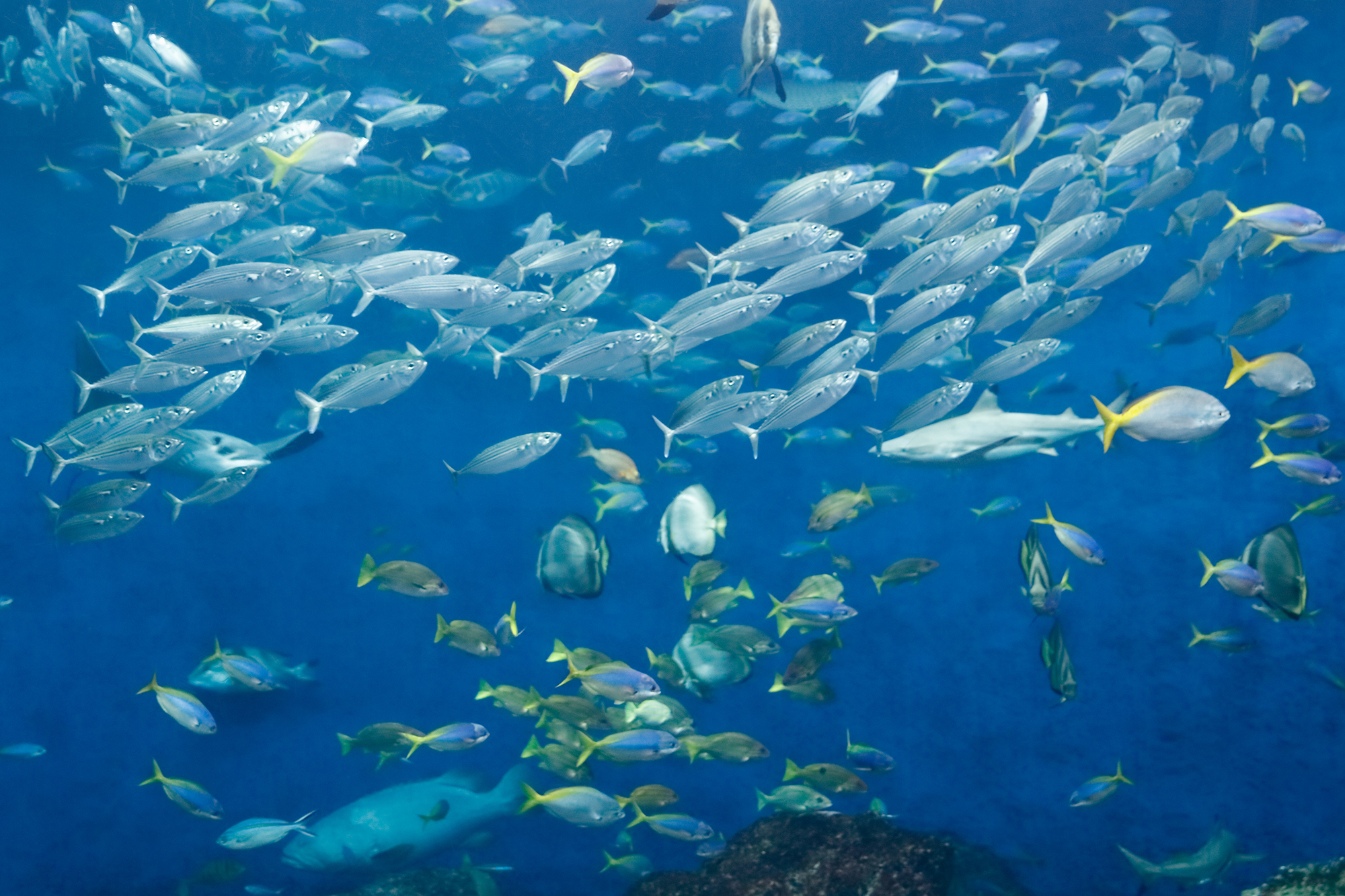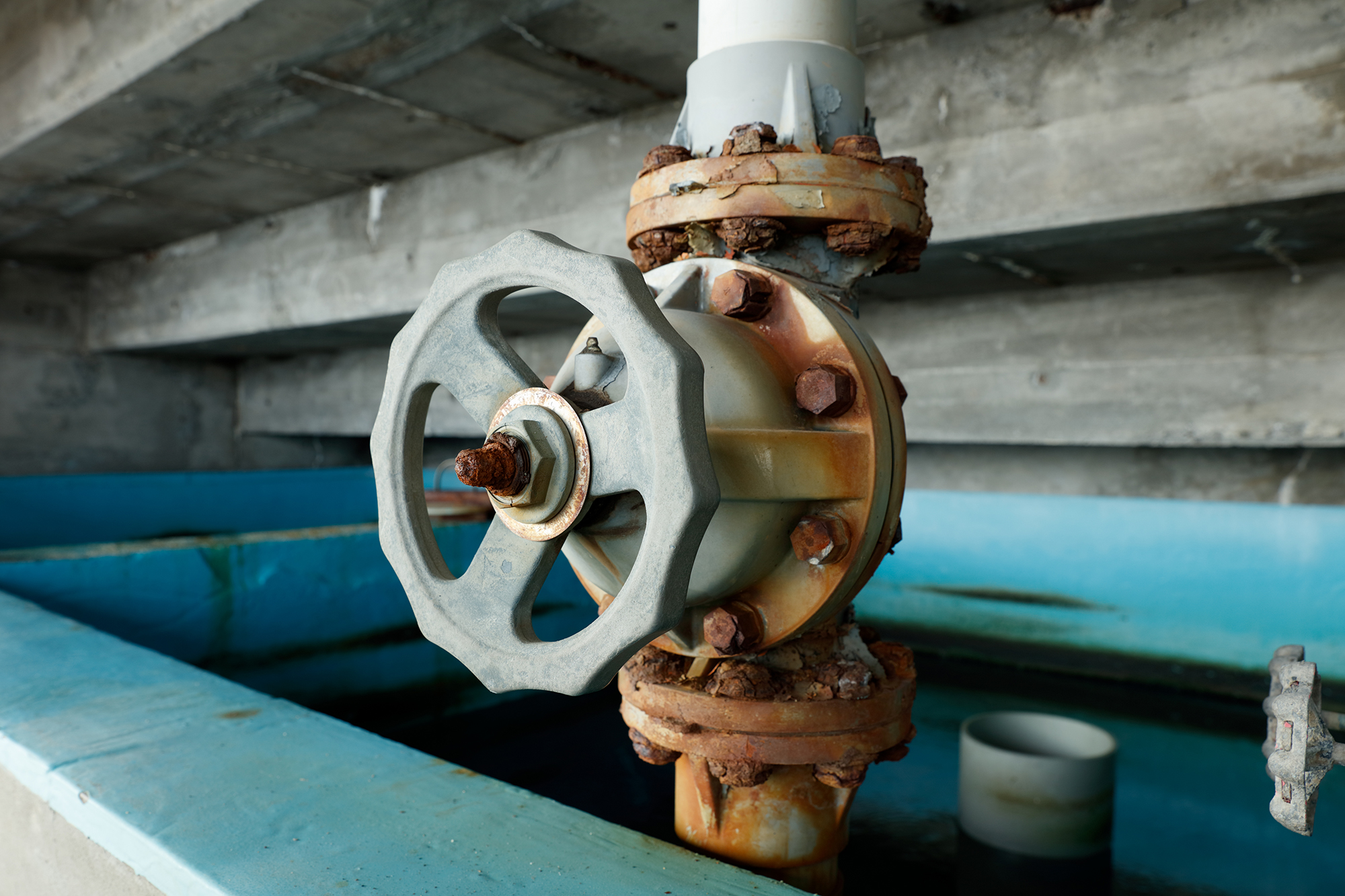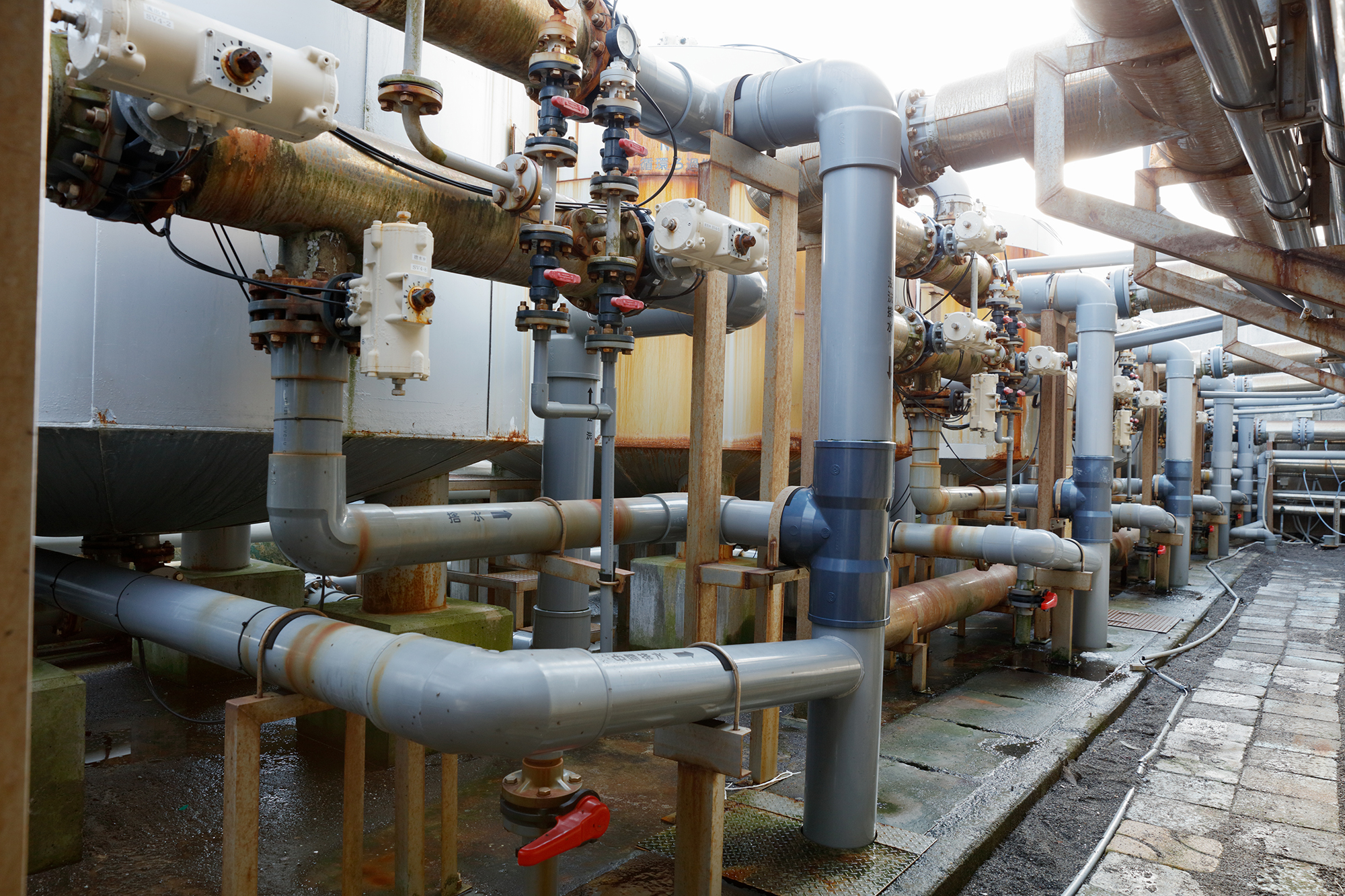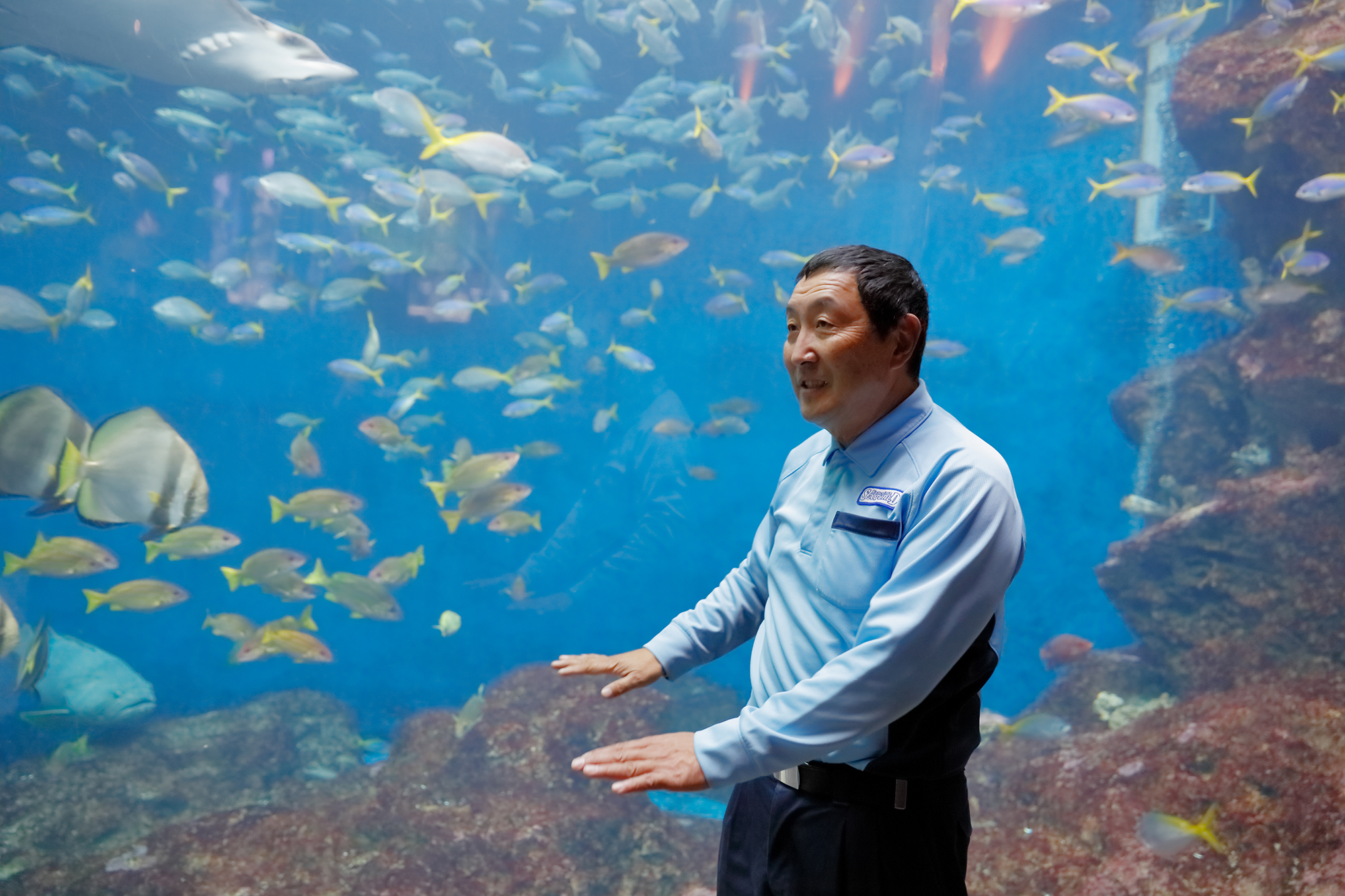Kamogawa Sea World is famous for its exciting Killer Whale Performance where water gets splashed on
the audience. Opened in 1970, it is one of Japan’s most venerable aquariums. ASAHI YUKIZAI has
installed plastic valves in over 90% of Japan’s aquariums, and Kamogawa Sea World is a valued
customer we have been supplying for more than 50 years. Seiichiro Kinoshita, the man in charge of
maintaining the facilities, spoke to us about the reliability of ASAHI AV valves.
We Cannot Shut Down Our Systems
Kamogawa Sea World’s roughly 23,000 m2 site contains 16 display areas. These include Ocean Stadium,
where visitors can enjoy the killer whale performance, and Surf Stadium, where there are
performances by bottlenose dolphins and Pacific white-sided dolphins. We are home to more than
11,000 fish, sea mammals and sea birds, who represent 800 different species. We are in the top three
Japanese aquariums in terms of the number of species we have here.
I started work at Kamogawa Sea World in 1981. I’ve been involved in maintaining the facilities
throughout my entire career. Our facilities can be roughly divided into two categories: ‘general
facilities’ used by our visitors, such as seating, viewing routes, restaurants, rest rooms, and the
hotel; and the ‘marine life living quarters’ where our fish, sea mammals and sea birds are kept. Any
malfunction in the marine life living quarters is a matter of life and death for the creatures kept
there, so we have to take the utmost care.
Water quality management is particularly difficult. Basically, we circulate and filter the water
used in the aquarium pools and tanks where our fish and sea mammals live. We use the circulation and
filtration equipment in combination with heat exchangers and sterilization equipment so that we can
maintain the appropriate level of water quality, water temperature, salinity, hydrogen ion
concentration (pH), and so on. If the water were to become contaminated, or the water temperature or
pH were to vary from the correct levels, in the worst case scenario, the creatures who live in that
water could die. The aquarium itself is closed for two days a month on average, but the marine life
living quarters are in operation around the clock, every day of the year. It would be totally
ridiculous to even think of temporarily stopping the water circulation system to carry out
maintenance work. That is why we only use absolutely reliable valves and pipes near the water tanks
and pools. We always use ASAHI YUKIZAI products because, with them, we can ensure the safety of our
precious 800 species of marine life, including our killer whales, dolphins, and belugas (white
whales).

Valves from 50 Years Ago Are Still Doing an Excellent Job
Kamogawa Sea World opened in October 1970. We celebrate our 50th anniversary this year, and we still
in fact have an ASAHI YUKIZAI valve that has been in use ever since we came into operation. The
metal nuts and bolts of the coupler have rusted from exposure to Sotobo-area’s salty breezes,
seaspray and strong UV rays, but the valve itself has never malfunctioned and continues to work
perfectly. Circulation and filtration systems operate in parallel, just in case. So if one system
should break down due to valve damage or something, another system can take up the slack. However,
that inevitably means the circulation and filtration is not as well performed. Aquariums can’t shut
down their systems, which is why we are so very grateful for products that don’t break.
We mainly use three types of valve here at Kamogawa Sea World: diaphragm valves, ball valves, and
butterfly valves. The majority of our valves are ball valves, but we select the type of valve to
match the location, so we use diaphragm valves where finely-balanced flow control is needed, and
butterfly valves where we want a large amount of flow in a short space of time.
It was before my time so I don’t know all the details, but I have heard that it was partly thanks to
ASAHI YUKIZAI that this aquarium was able to open. This is because ASAHI YUKIZAI was the world
leader in the development of plastic valves in the 1950s and 60s.
Up until then, the only valves that existed for water pipes were made from metal, such as brass, and
the trouble with them was that they were soon corroded by the flow of saltwater. It was therefore a
given that aquariums which mainly used seawater would frequently replace their valves. I think that
a huge amount of money, time and effort would have needed to be allocated to plumbing maintenance.
The launch of plastic valves with a high resistance to seawater and chemicals offered an instant
solution to that problem. Japan now has one of the largest number of aquariums in the world, and I
think that the existence of the plastic valve has contributed in no small way to that achievement.
 This ASAHAI YUKIZAI diaphragm valve has been in operation for 50 years, from the very
beginning of the aquarium right up to the present day (2020)
This ASAHAI YUKIZAI diaphragm valve has been in operation for 50 years, from the very
beginning of the aquarium right up to the present day (2020)
Opens When It Needs to Open, and Closes When It Needs to Close
People like me who are involved in aquarium equipment require a clear and simple function from a
valve. It must close properly when it needs to close, and open properly when it needs to open. It
sounds very simple, but there are not many products which can reliably accomplish that over a long
period of time.
Kamogawa Sea World’s killer whale pool, our largest, contains approximately 4,800 m3 of water. It’s
connected to several pieces of equipment, including eight pneumatic high-speed filtration systems
and circulation pumps, ozonators, sterilization equipment, and heat exchangers. One high-speed
filtration system and circulation pump can process 4 m3 of water per minute, so with eight sets we
can replace 32 m3 per minute.
In order to replace such a large volume of water (seawater) it is essential that each valve opens
and shuts properly just as we intended. If a valve that is meant to be open has not fully opened, or
if a valve that is meant to be shut has not fully closed, this will automatically lead to a
deterioration in water quality. And what is even worse is not being able to tell immediately which
valve is malfunctioning. There are dozens of pipe connections for the killer whale pool alone, so if
any water pollution occurs, it takes a huge amount of time to identify the cause. Having said that,
the flow of water must not be interrupted. If it takes too long to resolve the problem, there is the
possibility that severe damage will be done to the creatures that live in the water.
Bad water quality does not only endanger aquatic life, it also inconveniences the visitors to our
aquarium. This is because we must always maintain the purity of the water quality and improve
transparency in the water tank so that our visitors can see the fish.
Please look at the ‘Boundless Ocean’ tank behind me. It contains 650 m3 of water, 7.5 m deep, and
the fact that the brilliantly colored fish can be seen so clearly is proof that the ASAHI YUKIZAI
valves are doing an excellent job.
 The circulation and filtration system behind the killer whale pool is in operation
around the clock. Valves installed at dozens of locations finely control the flow of water
The circulation and filtration system behind the killer whale pool is in operation
around the clock. Valves installed at dozens of locations finely control the flow of water
